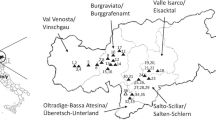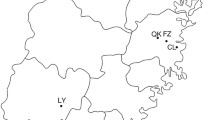Abstract
In this study, the population structure of the chestnut blight fungus Cryphonectria parasitica in the Aydın Mountains was investigated to make inferences about fungal reproduction and population diversity. A total of 213 C. parasitica isolates from eight subpopulations were used to determine vegetative compatibility (vc) and mating types of the population. Furthermore geostatistical analysis was performed to define the spatial structure of the population. The results showed that the isolates were vegetatively compatible with the European vc types of either EU-1 or EU-12. Both vc types were found in almost all subpopulations, but their frequencies varied depending on location. The results of a PCR assay showed that both mating types of C. parasitica (MAT-1 and MAT-2) exist in the population. MAT-1 comprised 65% of the total isolates, and the ratio of mating types was significantly skewed from 1:1. Genotyping based on combined vc and mating type data revealed four genotypes: EU-1/MAT-1 (28.6%), EU-1/MAT-2 (34.7%), EU-12/MAT-1 (36.2%) and EU-12/MAT-2 (0.5%). Geostatistatical analysis indicated that vc types, mating types and vc/mating genotypes were spatially autocorrelated and clustered in their distributions. Results suggested that C. parasitica could have a clonal population structure that is generated by asexual reproduction. Low vc-type diversity suggests that the C. parasitica population in the Aydın Mountains may be highly suitable to hypovirus invasion, thereby providing a high potential for successful biological control. However, co-occurrence of sexually compatible strains of EU-1 and EU-12 at the same locations in close proximity creates a high risk of increase in vc-type diversity.





Similar content being viewed by others
References
Akdoğan, S., & Erkman, E. (1968). Dikkat kestane kanseri görüldü. Tomurcuk, 1, 4–5.
Akıllı, S., Katırcıoğlu, Y. Z., & Maden, S. (2009). Vegetative compatibility types of Cryphonectria parasitica, causal agent of chestnut blight, in the Black Sea region of Turkey. Forest Pathology, 39, 390–396.
Anagnostakis, S. L. (1987). Chestnut blight: the classical problem of an introduced pathogen. Mycologia, 79, 23–37.
Anagnostakis, S. L. (2001). American chestnut sprout survival with biological control of the chestnut-blight fungus population. Forest Ecology and Management, 152, 225–233.
Anagnostakis, S. L., Hau, B., & Kranz, J. (1986). Diversity of vegetative compatibility groups of Cryphonectria parasitica in Connecticut and Europe. Plant Disease, 70, 536–538.
Biella, S., Smith, M. L., Aist, J. R., Cortesi, P., & Milgroom, M. G. (2002). Programmed cell death correlates with virus transmission in a filamentous fungus. Proceedings Biological Sciences, 269, 2269–2276.
Bissegger, M., Rigling, D., & Heiniger, U. (1997). Population structure and disease development of Cryphonectria parasitica in European chestnut forests in the presence of natural hypovirulence. Phytopathology, 87, 50–59.
Çeliker, N. M., & Onoğur, E. (2001). Evaluation of hypovirulent isolates of Cryphonectria parasitica for the biological control of chestnut blight. Forest Snow Landscape Research, 76, 378–382.
Cortesi, P., & Milgroom, M. G. (1998). Genetics of vegetative incompatibility in Cryphonectria parasitica. Applied and Environmental Microbiology, 64, 2988–2994.
Cortesi, P., McCulloch, C. E., Song, H., Lin, H., & Milgroom, M. G. (2001). Genetic control of horizontal virus transmission in the chestnut blight fungus, Cryphonectria parasitica. Genetics, 159, 107–118.
Durdu, Ö. F. (2009). Spatial predictions of surface water quality based on general regression neural network: a case study of the Büyük Menderes Catchment, Turkey. Fresenius’ Environmental Bulletin, 18, 1603–1613.
Dutech, C., Rossi, J. P., Fabreguettes, O., & Robin, C. (2008). Geostatistical genetic analysis for inferring the dispersal pattern of a partially clonal species: example of the chestnut blight fungus. Molecular Ecology, 17, 4597–4607.
Erincik, O., Doken, T. M., Acikgoz, S., & Ertan, E. (2003). First report for Aydın, Turkey:Cryphonectria parasitica (Murrill.) Barr. threatens the chestnut orchards. Journal of Turkish Phytopathology, 32, 41–44.
Erincik, O., Doken, T. M., & Acikgoz, S. (2007). Evaluation of occurrence of sexual reproduction in natural populations of Cryphonectria parasitica (Murr.) Barr and role of ascospores on chestnut blight spread in Aydın Province. Paper presented in International Workshop on Chestnut Management in Mediterranean Countries, Problems and Prospects, Bursa, Turkey, October.
Erincik, O., Döken, M. T., Açıkgöz, S., & Ertan, E. (2008). Characterization of Cryphonectria parasitica isolates collected from Aydın Province in Turkey. Phytoparasitica, 36, 249–259.
Grünwald, N. J., Goodwin, S. B., Milgroom, M. G., & Fry, W. E. (2003). Analysis of genotypic diversity data for populations of microorganisms. Phytopathology, 93, 738–746.
Gürer, M., Ottaviani, M. P., & Cortesi, P. (2001). Genetic diversity of subpopulations of Cryphonectria parasitica in two chestnut-growing regions in Turkey. Forest Snow Landscape Research, 76, 383–386.
Hoegger, P. J., Rigling, D., Holdenrieder, O., & Heiniger, U. (2000). Genetic structure of newly established populations of Cryphonectria parasitica. Mycological Research, 104, 1108–1116.
Jaime-Garcia, R., Orum, T. V., Felix-Gastelum, R., Trinidad-Correa, R., VanEtten, H. D., & Nelson, M. R. (2001). Spatial analysis of Phytophthora infestans genotypes and late blight severity on tomato and potato in the Del Fuerte Valley using geostatistics and geographic information systems. Phytopathology, 91, 1156–1165.
Krstin, L., Novak-Agbaba, S., Rigling, D., Krajacic, M., & Curcovic-Perica, M. (2008). Chestnut blight fungus in Croatia: diversity of vegetative compatibility types, mating types and genetic variability of associated Cryphonectria hypovirus 1. Plant Pathology, 57, 1086–1096.
Liu, Y.-C., & Milgroom, M. G. (1996). Correlation between hypovirus transmission and the number of vegetative incompatibility (vic) genes different among isolates from a natural population of Cryphonectria parasitica. Phytopathology, 86, 79–86.
Liu, Y.-C., Durrett, R., & Milgroom, M. G. (2000). A spatially-structured stochastic model to simulate heterogeneous transmission of viruses in fungal populations. Ecological Modelling, 127, 291–308.
Marra, R. E., & Milgroom, M. G. (2001). The mating system of the fungus Cryphonectria parasitica: selling and self-incompatibility. Heredity, 86, 134–143.
McGuire, I. C., Marra, R. E., & Milgroom, M. G. (2004). Mating-type heterokaryosis and selfing in Cryphonectria parasitica. Fungal Genetics and Biology, 41, 521–533.
Milgroom, M. G. (1995). Population biology of the chestnut blight fungus, Cryphonectria parasitica. Canadian Journal of Botany, 73, 311–319.
Milgroom, M. G., & Lipari, S. E. (1995). Spatial analysis of nuclear and mitochondrial RFLP genotypes in populations of the chestnut blight fungus, Cryphonectria parasitica. Molecular Ecology, 4, 633–642.
Milgroom, M. G., & Peever, T. L. (2003). Population biology of plant pathogens: the synthesis of plant disease epidemiology and population genetics. Plant Disease, 87, 608–617.
Milgroom, M. G., MacDonald, W. L., & Double, M. L. (1991). Spatial analysis of vegetative compatibility groups in the chestnut blight fungus, Cryphonectria parasitica. Canadian Journal of Botany, 69, 1407–1413.
Milgroom, M. G., Sotirovski, K., Spica, D., Davis, J. E., Brewer, M. T., Milev, M., et al. (2008). Clonal population structure of the chestnut blight fungus in expanding ranges in southeastern Europe. Molecular Ecology, 17, 4446–4458.
Montenegro, D., Aguin, O., Sainz, M. J., Hermida, M., & Mansilla, J. P. (2008). Diversity ofvegetative compatibility types, distribution of mating types and occurrence of hypovirulence of Cryphonectria parasitica in chestnut stands in NW Spain. Forest Ecology and Management, 256, 973–980.
Pannatier, Y. (1994). VarioWin 2.1. Switzerland: Institute of Mineralogy and Petrography, University of Lausanne.
Perlerou, C., & Diamandis, S. (2006). Identification and geographic distribution of vegetativecompatibility types of Cryphonectria parasitica and occurrence of hypovirulence in Greece. Forest Pathology, 36, 413–421.
Robin, C., & Heiniger, U. (2001). Chestnut blight in Europe: diversity of Cryphonectria parasitica, hypovirulence and biocontrol. Forest Snow and Landscape Research, 76, 361–367.
Sotirovski, K., Papazova-Anakieva, I., Grünwald, N. J., & Milgroom, M. G. (2004). Low diversity of vegetative compatibility types and mating type in Cryphonectria parasitica in thesouthern Balkans. Plant Pathology, 53, 325–333.
Acknowledgements
We thank Assist. Prof. Dr. Levent Atatanir, from the Department of Soil Science, Faculty of Agriculture, Adnan Menderes University, Aydın (Turkey) for technical assistance in the preparation of Fig. 1.
Author information
Authors and Affiliations
Corresponding author
Rights and permissions
About this article
Cite this article
Erincik, Ö., Özdemir, Z., Durdu, Ö.F. et al. Diversity and spatial distribution of vegetative compatibility types and mating types of Cryphonectria parasitica in the Aydın Mountains, Turkey. Eur J Plant Pathol 129, 555–566 (2011). https://doi.org/10.1007/s10658-010-9719-5
Accepted:
Published:
Issue Date:
DOI: https://doi.org/10.1007/s10658-010-9719-5




